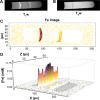Quantitative [Fe]MRI of PSMA-targeted SPIONs specifically discriminates among prostate tumor cell types based on their PSMA expression levels
- PMID: 26855574
- PMCID: PMC4725637
- DOI: 10.2147/IJN.S93409
Quantitative [Fe]MRI of PSMA-targeted SPIONs specifically discriminates among prostate tumor cell types based on their PSMA expression levels
Abstract
We report the development, experimental verification, and application of a general theory called [Fe]MRI (pronounced fem-ree) for the non-invasive, quantitative molecular magnetic resonance imaging (MRI) of added magnetic nanoparticles or other magnetic contrast agents in biological tissues and other sites. [Fe]MRI can easily be implemented on any MRI instrument, requiring only measurements of the background nuclear magnetic relaxation times (T1, T2) of the tissue of interest, injection of the magnetic particles, and the subsequent acquisition of a pair of T1-weighted and T2-weighted images. These images, converted into contrast images, are subtracted to yield a contrast difference image proportional to the absolute nanoparticle, iron concentration, ([Fe]) image. [Fe]MRI was validated with the samples of superparamagnetic iron oxide nanoparticles (SPIONs) both in agarose gels and bound to human prostate tumor cells. The [Fe]MRI measurement of the binding of anti-prostate specific membrane antigen (PSMA) conjugated SPIONs to PSMA-positive LNCaP and PSMA-negative DU145 cells in vitro allowed a facile discrimination among prostate tumor cell types based on their PSMA expression level. The low [Fe] detection limit of ~2 μM for SPIONs allows sensitive MRI of added iron at concentrations considerably below the US Food and Drug Administration's human iron dosage guidelines (<90 μM, 5 mg/kg).
Keywords: RT-PCR; contrast difference; flow cytometry.
Figures








Similar articles
-
Quantitative [Fe]MRI determination of the dynamics of PSMA-targeted SPIONs discriminates among prostate tumor xenografts based on their PSMA expression.J Magn Reson Imaging. 2018 Aug;48(2):469-481. doi: 10.1002/jmri.25935. Epub 2018 Jan 13. J Magn Reson Imaging. 2018. PMID: 29331081 Free PMC article.
-
MRI Assessment of Prostate-Specific Membrane Antigen (PSMA) Targeting by a PSMA-Targeted Magnetic Nanoparticle: Potential for Image-Guided Therapy.Mol Pharm. 2019 May 6;16(5):2060-2068. doi: 10.1021/acs.molpharmaceut.9b00036. Epub 2019 Apr 10. Mol Pharm. 2019. PMID: 30912947
-
In Vivo Molecular MRI Imaging of Prostate Cancer by Targeting PSMA with Polypeptide-Labeled Superparamagnetic Iron Oxide Nanoparticles.Int J Mol Sci. 2015 Apr 28;16(5):9573-87. doi: 10.3390/ijms16059573. Int J Mol Sci. 2015. PMID: 25927579 Free PMC article.
-
Iron-based superparamagnetic nanoparticle contrast agents for MRI of infection and inflammation.AJR Am J Roentgenol. 2015 Mar;204(3):W302-13. doi: 10.2214/AJR.14.12733. AJR Am J Roentgenol. 2015. PMID: 25714316 Free PMC article. Review.
-
[Updated application of prostate-specific membrane antigen to the diagnosis and treatment of prostate cancer].Zhonghua Nan Ke Xue. 2008 Jan;14(1):79-82. Zhonghua Nan Ke Xue. 2008. PMID: 18297820 Review. Chinese.
Cited by
-
Longitudinal monitoring of microglial/macrophage activation in ischemic rat brain using Iba-1-specific nanoparticle-enhanced magnetic resonance imaging.J Cereb Blood Flow Metab. 2020 Dec;40(1_suppl):S117-S133. doi: 10.1177/0271678X20953913. Epub 2020 Sep 22. J Cereb Blood Flow Metab. 2020. PMID: 32960690 Free PMC article.
-
The Potential of Nanotechnology in Medically Assisted Reproduction.Front Pharmacol. 2018 Jan 11;8:994. doi: 10.3389/fphar.2017.00994. eCollection 2017. Front Pharmacol. 2018. PMID: 29375388 Free PMC article.
-
Synthesis and Application of Fe3O4@Au Composite Nanoparticles as Magnetic Resonance/Computed Tomography Dual-Modality Contrast Agent.J Med Signals Sens. 2020 Jul 3;10(3):201-207. doi: 10.4103/jmss.JMSS_55_19. eCollection 2020 Jul-Sep. J Med Signals Sens. 2020. PMID: 33062612 Free PMC article.
-
Current Imaging Techniques for Lymph Node Staging in Prostate Cancer: A Review.Front Surg. 2018 Dec 7;5:74. doi: 10.3389/fsurg.2018.00074. eCollection 2018. Front Surg. 2018. PMID: 30581819 Free PMC article. Review.
-
Druggability of Targets for Diagnostic Radiopharmaceuticals.ACS Pharmacol Transl Sci. 2023 Jul 12;6(8):1107-1119. doi: 10.1021/acsptsci.3c00081. eCollection 2023 Aug 11. ACS Pharmacol Transl Sci. 2023. PMID: 37588760 Free PMC article. Review.
References
-
- Shin TH, Choi Y, Kim S, Cheon J. Recent advances in magnetic nanoparticle-based multi-modal imaging. Chem Soc Rev. 2015;44(14):4501–4516. - PubMed
-
- Lo YL, Chou HL, Liao ZX, et al. Chondroitin sulfate-polyethylenimine copolymer-coated superparamagnetic iron oxide nanoparticles as an efficient magneto-gene carrier for microRNA-encoding plasmid DNA delivery. Nanoscale. 2015;7(18):8554–8565. - PubMed
-
- Wang C, Ding C, Kong M, et al. Tumor-targeting magnetic lipoplex delivery of short hairpin RNA suppresses IGF-1R overexpression of lung adenocarcinoma A549 cells in vitro and in vivo. Biochem Biophys Res Commun. 2011;410(3):537–542. - PubMed
Publication types
MeSH terms
Substances
Grants and funding
LinkOut - more resources
Full Text Sources
Other Literature Sources
Medical
Miscellaneous

